NVIDIA Announces the GeForce RTX 20 Series: RTX 2080 Ti & 2080 on Sept. 20th, RTX 2070 in October
by Ryan Smith on August 20, 2018 4:00 PM ESTGeForce RTX 2080
Moving down the stack, we have the GeForce RTX 2080. Normally the king of an NVIDIA launch product stack, this cycle’s x80 card is instead playing second-seat to the RTX 2080 Ti. However in terms of pricing and the general market position, it remains in a similar position.
| NVIDIA GeForce x80 Specification Comparison | ||||||
| RTX 2080 Founder's Edition |
RTX 2080 | GTX 1080 | GTX 980 | |||
| CUDA Cores | 2944 | 2944 | 2560 | 2048 | ||
| ROPs | 64? | 64? | 64 | 64 | ||
| Core Clock | 1515MHz | 1515MHz | 1607MHz | 1126MHz | ||
| Boost Clock | 1800MHz | 1710MHz | 1733MHz | 1216MHz | ||
| Memory Clock | 14Gbps GDDR6 | 14Gbps GDDR6 | 10Gbps GDDR5X | 7Gbps GDDR5 | ||
| Memory Bus Width | 256-bit | 256-bit | 256-bit | 256-bit | ||
| VRAM | 8GB | 8GB | 8GB | 4GB | ||
| Single Precision Perf. | 10.6 TFLOPs | 10.1 TFLOPs | 8.9 TFLOPs | 5.0 TFLOPs | ||
| "RTX-OPS" | 60T | 60T | N/A | N/A | ||
| TDP | 225W | 215W | 180W | 165W | ||
| GPU | Unknown Turing | Unknown Turing | GP104 | GM204 | ||
| Architecture | Turing | Turing | Pascal | Maxwell | ||
| Manufacturing Process | TSMC 12nm "FFN" | TSMC 12nm "FFN" | TSMC 16nm | TSMC 28nm | ||
| Launch Date | 09/20/2018 | 09/20/2018 | 05/27/2016 | 09/18/2014 | ||
| Launch Price | $799 | $699 | MSRP: $599 Founders $699 |
$549 | ||
NVIDIA has not disclosed anything about the GPU used here. As I highly doubt it’s using Big Turing, I expect we’re looking at the next Turing down, which would presumably be TU104. And although we don’t have die size or transistor counts, in terms of functionality it appears to be a straight smaller version of Big Turing, featuring a proportional number of CUDA, tensor, and RT cores.
Altogether we’re looking at 2944 CUDA cores paired with what should be 368 tensor cores. I expect that like the RTX 2080 Ti, for the RTX 2080 what we’re looking at is not a fully-enabled TR104 part, especially as the similar Quadro RTX 5000 has slightly better specifications. Also like the RTX 1080 Ti, clockspeeds have dropped a bit from generation to generation, as the base clock is down to 1515MHz and the boost clock to 1710MHz. All told we’re looking at a pure CUDA core compute throughput of 10.1 TFLOPs, about 13% higher than the GTX 1080. Or if we compare it to the RTX 2080 Ti, we’d see around 75% of the expected compute/tensor performance, which is only a bit larger than the jump we saw between the GTX 1080 and GTX 1080 Ti.
Meanwhile it’s clear that the card will come with a fully enabled memory bus, meaning we’re looking at 8GB of GDDR6 running at 14Gbps, on top of a 256-bit memory bus. Relative to the GTX 1080 this is an even more significant 40% increase in memory bandwidth.
As for TDPs, they’ve gone up for this band of cards. The stock RTX 2080 will have a 215W TDP, up 30W from the GTX 1080’s 180W TDP, and an even bigger increase if we look at GTX 980’s 165W TDP. It’s no secret that NVIDIA is fighting a losing battle with Moore’s Law here, and barring massive efficiency improvements, there is a need to increase TDPs to keep up overall performance. TU104 is undoubtedly also a big chip, and without a full node shrink, it would seem that NVIDIA has to pay a power penalty instead. In the meantime this higher TDP also negates some of the RTX 2080 Ti’s power disadvantage, as now that gap is just 35W instead of 65W.
Past that, NVIDIA is offering an overclocked Founders Edition card here as they are with the RTX 2080 Ti. The RTX 2080 Founders Edition will ship with an 1800MHz boost clock (up 5%), and the TDP will be 10W higher at 225W.
Power delivery for the 2080 FE and similar reference cards will be a 6pin + 8pin configuration, which on paper is good for 300W. NVIDIA's official PCB photo for the card shows a similar VRM configuration as the 2080 Ti, so that means we're looking at what appears to be 10 phases driving the GPU among 13 phases in total. NVIDIA has also disclosed that the RTX 2080 Founders Edition in particular has an overclocking power limit of 280W, confirming earlier claims about being more overclocking-friendly than past reference designs.
The Founders Edition card will also retain the same dual fan reference cooling design as its bigger sibling, right down to its 10.5-inch long physical dimensions. This also includes the card-length vapor chamber that's used on the RTX 2080 Ti as well. So the only difference between the two cards, other than the power connectors, will be on the inside. Which also means that NVIDIA’s 2080 reference PCB will use the same 3x DisplayPort + 1x HDMI + 1x USB Type-C configuration as the other card.
Finally, in terms of pricing, the RTX 2080 will also be seeing a price hike over the last generation. Though not as significantly as the RTX 2080 Ti. The MSRP for a stock card will be $699, $100 over the launch price of the GTX 1080 and $200 over its current list price. Meanwhile the Founders Edition card will carry a further $100 premium, pushing it to $799. Finally, like the RTX 2080 Ti, the 2080 will be shipping in the first wave of cards on September 20th.
GeForce RTX 2070
The final member of the new GeForce RTX family is the GeForce RTX 2070. Traditional for its roots, this is the “value” enthusiast card, giving up some of the RTX 2080’s performance in exchange for a lower price. Though with prices starting at $499, “value” and “cheap” are not the same thing.
| NVIDIA GeForce x70 Specification Comparison | ||||||
| RTX 2070 Founder's Edition |
RTX 2070 | GTX 1070 | GTX 970 | |||
| CUDA Cores | 2304 | 2304 | 1920 | 1664 | ||
| ROPs | 64? | 64? | 64 | 64 | ||
| Core Clock | 1410MHz | 1410MHz | 1506MHz | 1050MHz | ||
| Boost Clock | 1710MHz | 1620MHz | 1683MHz | 1178MHz | ||
| Memory Clock | 14Gbps GDDR6 | 14Gbps GDDR6 | 8Gbps GDDR5 | 7Gbps GDDR5 | ||
| Memory Bus Width | 256-bit | 256-bit | 256-bit | 256-bit | ||
| VRAM | 8GB | 8GB | 8GB | 4GB | ||
| Single Precision Perf. | 7.9 TFLOPs | 7.5 TFLOPs | 6.5 TFLOPs | 3.9 TFLOPs | ||
| "RTX-OPS" | 45T | 45T | N/A | N/A | ||
| TDP | 185W | 175W | 150W | 145W | ||
| GPU | Unknown Turing | Unknown Turing | GP104 | GM204 | ||
| Architecture | Turing | Turing | Pascal | Maxwell | ||
| Manufacturing Process | TSMC 12nm "FFN" | TSMC 12nm "FFN" | TSMC 16nm | TSMC 28nm | ||
| Launch Date | 09/20/2018 | 09/20/2018 | 06/10/2016 | 09/18/2014 | ||
| Launch Price | $599 | $499 | MSRP: $379 Founders $449 |
$329 | ||
Like the 2080, we don’t know the specific GPU being used here. But it’s almost certainly a somewhat significantly cut-down TU104. NVIDIA has shaved off several SMs here, resulting in 2304 CUDA cores and what should be 288 tensor cores. Meanwhile ray tracing performance is rated at 6 GigaRays/second.
Like the other RTX cards, clockspeeds have dropped a bit versus the previous generation; the base clock now starts at 1410MHz, and the boost clock is 1620MHz. On paper then, compute throughput works out to 7.5 TFLOPs, up 15% from GTX 1070. Or if we compare it to the 2080, the 2070 should deliver around 75% of its bigger sibling’s compute performance, which makes the jumps between the 2070, 2080, and 2080 Ti all very symmetrical. This is also an ever so slightly smaller gap than what was between the GTX 1080 and GTX 1070.
Also like the RTX 2080, this appears to be a fully enabled memory configuration. Meaning we’re looking at 8GB of GDDR6 running at 14Gbps, on top of a 256-bit memory bus. Relative to the GTX 1070 this is the single greatest bandwidth increase of all of the RTX cards; the 2070 will enjoy a 75% increase in memory bandwidth over its Pascal predecessor, as the GTX 1070 never did use GDDR5X.
TDPs have gone up here as well. The RTX 2070 is rated for 175W, up from 150W for the GTX 1070, and 145W for the GTX 970. As with the RTX 2080, it looks like NVIDIA is paying for their performance and new features via higher power consumption in lieu of a full node shrink.
Past that, NVIDIA is offering an overclocked Founders Edition card here as well. The RTX 2070 Founders Edition will ship with a 1710MHz boost clock (up 6%), and the TDP will be 10W higher at 185W.
Power delivery for the 2080 FE and similar reference cards will be a single 8pin connector, which on paper is good for 225W. Notably, thanks in part to cutting out a power connector, this card is shorter than the RTX 2080 – as is often the case for x70 cards – and comes in at just 9-inches long. Consequently, while the Founders Edition card retains the same basic industrial design as the other RTX cards, it’s not going to be the same exact shroud, owing to the shorter size and lack of an NVLink connector.
Otherwise in terms of display outputs, NVIDIA’s reference PCB is the same as the other cards: 3x DisplayPort + 1x HDMI + 1x USB Type-C.
Finally, in terms of pricing, like all the other RTX cards, the RTX 2070 will be seeing a price hike over the last generation. The MSRP for a stock card will be $499, $120 over the launch price of the GTX 1070 and around $100 over its current list price. Meanwhile the Founders Edition card will carry a further $100 premium, pushing it to $599.
However unlike the top two cards, the RTX 2070 will not be shipping on September 20th. While NVIDIA has announced the card, both their Founders Edition card as well as partner cards will not be shipping until some point in October. Consequently, pre-orders are not available at this time. Which coincidentally brings us to our final point…
Pre-Orders Starting Now
As mentioned in the introduction to this article, NVIDIA and its board partners are already taking pre-orders on the new GeForce RTX cards. As a general piece of advice, we caution against pre-ordering new hardware until it can be properly reviewed by a reputable third party (i.e. us). However in the case of the GeForce RTX series I feel that this is especially important, as NVIDIA has provided no meaningful guidance when it comes to performance expectations. So we don’t even know how well these cards will perform relative to their Pascal predecessors on current-generation games.
None the less, unless NVIDIA is sitting on a massive launch inventory, I have to admit that I have trouble believing that retailers will remain in stock ahead of the September 20th launch. Launch-day sell-outs have become common for video cards, and even with the unfortunate use of pre-orders here, it wouldn’t be surprising to see pre-orders run out before we reach the 20th. So potential buyers will have some hard choices to make if they want to ensure they have a card on launch day.
Meanwhile as far as pricing is concerned, while NVIDIA does have their $999/$699/$499 baseline MSRPs, the reality is that you won’t be able to find cards at these prices. And likely won’t be able to for weeks or months. The launch-day sell-out phenomena means that board partners have prioritized higher-end card designs, with pricing to match. As of this afternoon, I have not seen an RTX 2080 card listed below $749, and most are at or over the $799 price tag of the Founders Edition card. The gap is even bigger for RTX 2080 Ti cards, where I haven’t seen any for less than $1150. So there’s certainly merit to any arguments that at least for the launch, prices are closer to $1150 and $750 respectively.
None the less, if you are looking to pre-order a card, Newegg, Amazon, and NVIDIA are all taking pre-orders while they last. So at the very least there is a reasonable choice of retailers to choose from. We have not had a chance to dig into any of the board partners’ cards yet, but it would appear that this is going to be a semi-custom launch: that is, everyone is shipping a card using NVIDIA’s reference PCB and then their own custom cooler on top of it. So cooling aside, all of the launch-day cards should offer similar features.


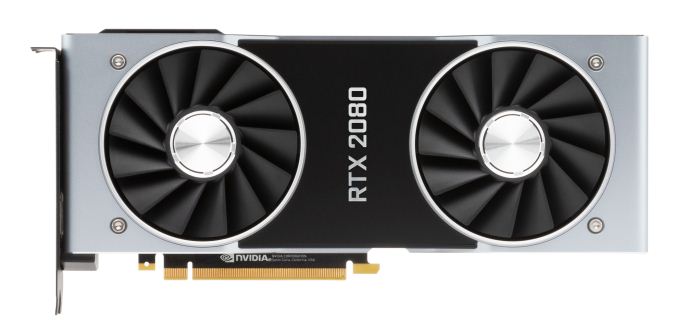
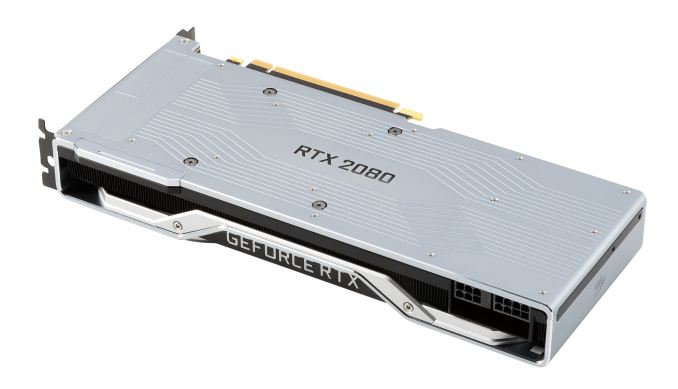
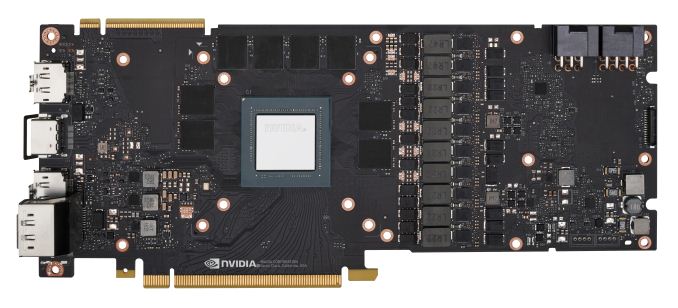
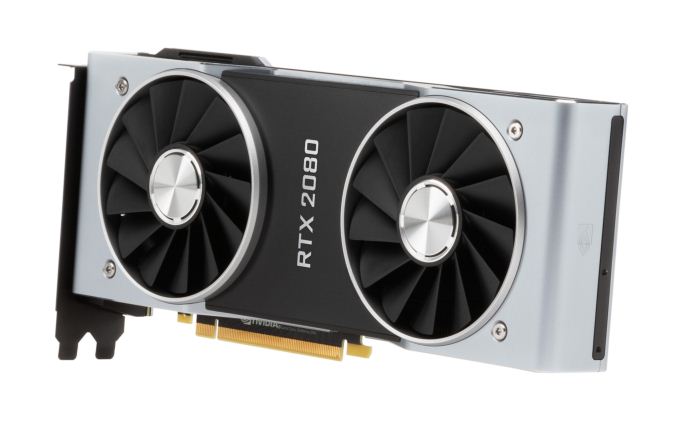
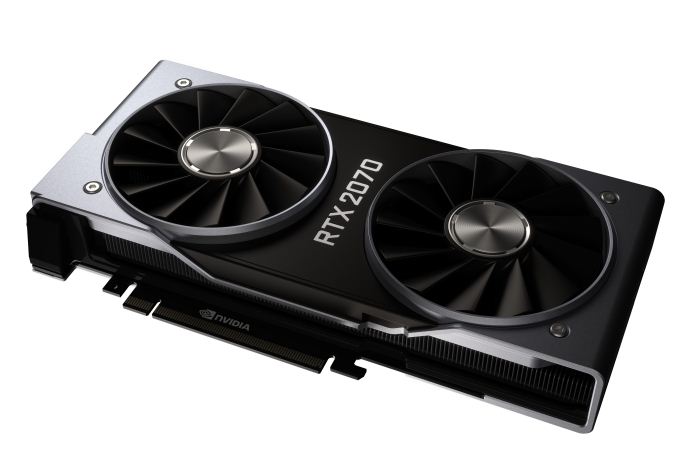
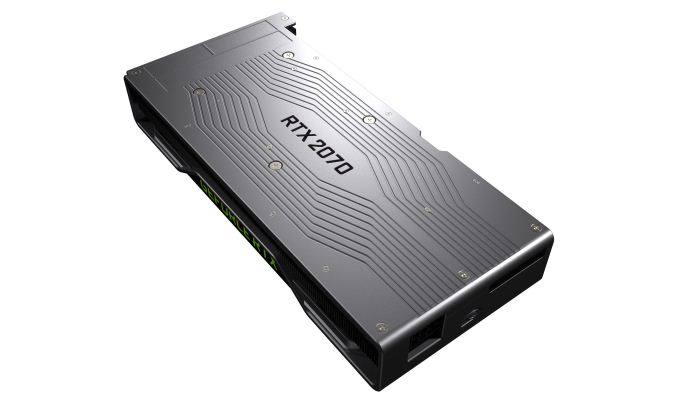
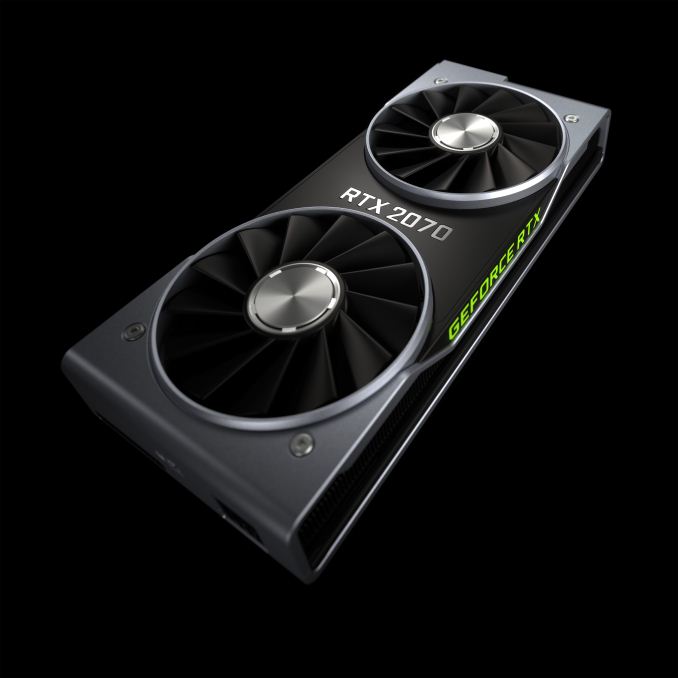








223 Comments
View All Comments
Yojimbo - Tuesday, August 21, 2018 - link
He never said 8800 GTX, he said 8800. There were a lot of 8800 GPUs and the 8800 Ultra launched for $830 in 2007, which is over 1,000 2018 dollars.eddman - Tuesday, August 21, 2018 - link
Then he'd be wrong if he meant Ultra, since 8800 GTX is the equivalent card to 2080. Also, the 8 series launched with 8800 GTX, not Ultra, which launched 6 months later simply because of lack of proper competition from AMD in order to maximize profits.Yojimbo - Tuesday, August 21, 2018 - link
He never said 2080, either, so why is her wrong? The 2080 doesn't cost $1,000. One can argue that the 2080 Ti is the 8800 Ultra coming out 6 months earlier, for which is actually deserves a price premium. As technology performance increases, the value of current technology goes down over time, so something coming out now is more valuable than something coming out 6 months from now.eddman - Tuesday, August 21, 2018 - link
... because he replied to my comment where I compared 2080 to 1080. Isn't that obvious?No, 2080 Ti can be compared to 1080 Ti, 980 Ti, etc. and it is quite more expensive.
Yojimbo - Tuesday, August 21, 2018 - link
I am not following your reasoning. You mentioned the 2080 and the 2080 Ti. You compared the 2080 to the 1080. Why does that preclude him from being able to compare the 2080 to the GTX 8800 and the 2080 Ti to the 8800 Ultra?The 2080 Ti can be compared to 1080 Ti but not to 8800 Ultra? Why? Because you said so? The 1080 Ti does not match his "new technology" thesis. If you're gonna refute his thesis you need to work with it, not just ignore it.
As far as supporting his thesis, I think a better argument is the increase in die size of the GPUs in question and the fact that in NVIDIA's latest earnings conference call they projected that gross margins would go down next quarter, not up. That suggests that, assuming they sell a significant number of these new cards next quarter, these increased prices do seem to have a correlation to increased manufacturing costs, and not just "NVIDIA raising prices because they can". If they were raising prices "because they can" (which every company is trying to do!) then their margins should be increasing.
eddman - Tuesday, August 21, 2018 - link
... because at first I was comparing 2080 to 1080 and he replied to that.8800 Ultra was a massively overpriced card because of no competition. It didn't offer anything besides a bit higher clock speeds. It simply existed to make more money. If that new technology's cost was that crippling, nvidia would've priced 8800 GTX more.
Thinking that these cards are this expensive ONLY because of their new technologies is naive. I don't doubt they could sell these at Pascal level prices and still make a lot of profit. They'd have simply recuperated their expenses a bit later.
These new technologies might be playing a role in pricing but based on nvidia's track record it's safe to say that the biggest reason here is lack of competition.
P.S. I have nothing against nvidia and might even upgrade to a 2070 from my 1060.
Yojimbo - Tuesday, August 21, 2018 - link
"It simply existed to make more money."Products in general simply exist to make money. Of course someone can develop or champion something for another reason, but if it isn't fulfilling a desire in the market, in which case it can make money, then it's bound to fail.
"Thinking that these cards are this expensive ONLY because of their new technologies is naive."
No it's not, as shown by the gross margins argument I have made.
"These new technologies might be playing a role in pricing but based on nvidia's track record it's safe to say that the biggest reason here is lack of competition."
That simply isn't true. Based on the track record the prices have not gone up in relation despite NVIDIA's lack of competition in the PC gaming space. It's just something people repeat. In fact what has happened is a greater number of people have bought the higher priced cards than in previous generations. Why? Because the graphics cards have become more and more important to the performance of gaming systems in relation to the other components of the system. There also is less of a need to spend extra money on the system for uses of the systems besides gaming. Spreadsheets, word processors, compression tools, maintenance utilities, etc, used to tax
the hardware relative to its maximum performance much more than they do now. Therefore that money saved on the other uses for the system can be re-allocated towards the graphics card to improve the gaming experience.
eddman - Tuesday, August 21, 2018 - link
The point was that 8800 UItra was a mere cash grab. It didn't have to be that expensive or even exist, but nvidia did it since they knew AMD can't respond and that there are enough people to sell these cards to. Easy money. Nothing inherently wrong with that tough.Margins are expected to go down but it doesn't mean they couldn't have priced the cards lower. Yes, they made a lot of investments which had an effect on profit, but there is no reason to think that lower prices would've resulted in losses. They still would've made the money back but at a bit later date.
Prices DID go up after fermi.
Yojimbo - Tuesday, August 21, 2018 - link
"The point was that 8800 UItra was a mere cash grab. It didn't have to be that expensive or even exist, but nvidia did it since they knew AMD can't respond and that there are enough people to sell these cards to. Easy money. Nothing inherently wrong with that tough."Why do any graphics cards have to exist? Why can't NVIDIA raise chickens instead? Huang can be a long-haul trucker. The only way a product "has to be a certain price" is if a company can't possibly sell it for less without going out of business, I guess. If a company is pricing their products that way then they are in big, big trouble. So of course it was a "cash grab" priced to maximize profits. That's how products are priced! It's ubiquitous. It isn't special to the 8800 Ultra. And since it is ubiquitous the argument cannot possibly be used to refute a claim that the 8800 Ultra cost more because of new technology. It's entirely possible that the only reason people were willing to pay that much money for the card was because of its combination of performance and new technology. You have to realize that companies don't just set the price and then that's it. A company must always obey the market with their prices, otherwise they will lose money in comparison to obeying the market. It's the market that sets the price.
"Margins are expected to go down but it doesn't mean they couldn't have priced the cards lower."
Yes sure, margins could have gone down even more. Margins could even go to zero. They could sell the card at cost for a while before they tank their business. What's your point? We are arguing about whether they are "squeezing consumers" more not whether they are NOT "squeezing consumers" less!
"Prices DID go up after fermi."
No, the GTX 480 debuted at $499. 499 2010 dollars is 577 2018 dollars. Besides, AMD was still competitive during the Kepler days. The GTX 780 debuted at 649 2013 dollars, which is 702 2018 dollars. That's actually right where the GTX 2080 is debuting. Maxwell was when AMD was least competitive and the GTX 980 debuted at 549 2014 dollars which is 584 2018 dollars. So the price went down significantly, right in line with the GTX 480 debut price. This even though NVIDIA had much less competition with Maxwell and the GPU was more important to the total gaming performance of the system in 2014 compared to 2010.
Yojimbo - Tuesday, August 21, 2018 - link
What I think is true is that with more AMD competition in the past prices dropped after after the debut. You can't use the Pascal generation for that comparison though, because it was a unique situation due to the crypto-currency craze and skyrocketing DRAM prices.